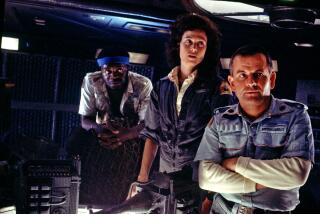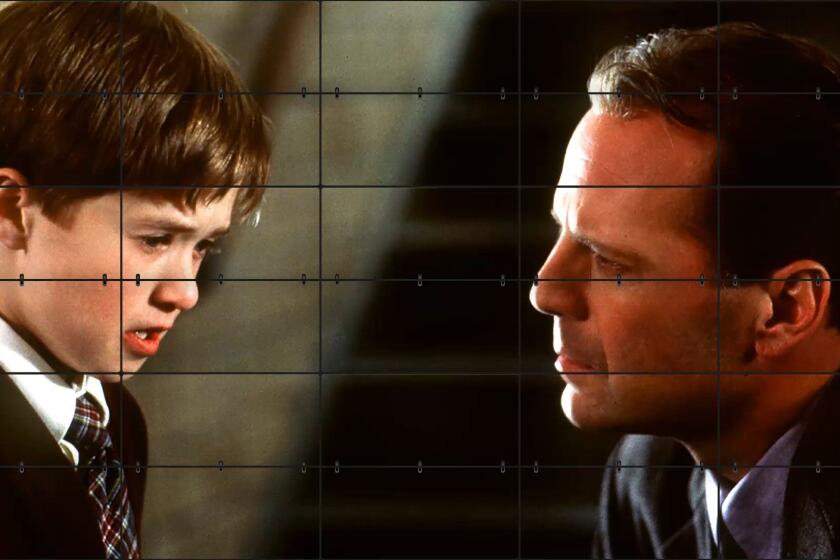Review: What made Ridley Scott’s ‘Alien’ a sci-fi game changer? The documentary ‘Memory’ has the answer
Sure, in space, no one can hear you scream. But “Memory: The Origins of ‘Alien,’” a well-mounted peek behind the scenes of Ridley Scott’s 1979 science-fiction masterpiece, is more interested in what you can see, as well as what you cannot unsee. And there are few things in the horror lexicon more unseeable than “Alien’s” notorious chest-burster sequence, when John Hurt’s Kane doubles over in agony and has his torso ruptured by what looks, in the memorable words of cast member Veronica Cartwright, “like a penis with teeth.”
That the creature’s visual inspiration actually came from Francis Bacon’s triptych “Three Studies for Figures at the Base of a Crucifixion” is one of many incidental details that help make “Memory” a rich and diverting piece of film scholarship. You also learn about some of the sequence’s practical logistics: the painstaking refinement of the alien’s design, the horrible stench that arose from all the buckets of blood and beef offal that had been poured into the artificial chest cavity, the attempts to keep Hurt’s costars as in the dark as possible about what was going to happen.
Perhaps you know those details already; more than a few graduate papers and oral histories have been devoted to deconstructing the sequence and teasing out what makes it so startling even 40 years later. Swiss-born director Alexandre O. Philippe treats it in much the same way he treated “Psycho’s” shower scene, the subject of his equally obsessive and enjoyable 2017 documentary, “78/52.” Those two game-changing moments in cinematic horror more than merit comparison: They sneaked up on audiences so craftily that it felt as though some unspoken narrative contract had been violated. Movies would never be the same.
Fittingly, Philippe bides his time before getting to the chest-burster scene, and he teases us with the possibility that he might not even show it at all. There is plenty to distract the viewer with in the meantime. Marshaling a formidable army of professors, filmmakers (hello, Roger Corman) and other enthused “Alien” analysts, “Memory” dives into the life and work of screenwriter Dan O’Bannon, who concocted the movie under the working title “Star Beast.” Some of his other projects, including the 1974 science-fiction comedy “Dark Star” and Alejandro Jodorowsky’s aborted adaptation of “Dune,” played their own influential roles in “Alien’s” rich and complicated lineage.
It was while working on “Dune” that the writer met Swiss artist H.R. Giger, regularly identified alongside O’Bannon and Scott as one of “Alien’s” principal architects. Much admiration is justly lavished on the exquisite Lovecraftian qualities of Giger’s designs, his creation of a monster whose various slime-dripping protuberances managed to be hideous, beautiful and unnervingly sexual all at once. It was Giger who gave “Alien” its vision. It was Scott, with just one feature (“The Duellists”) under his belt, who gave the movie its impact.
To watch “Alien” now is to marvel at just how patient and stealthily elegant a picture it is, particularly in its first hour, with its creeping camera movements, hypnotic pacing and enveloping, womb-like sense of dread. Released today, it would no doubt feel like an art film among so many noisier, clunkier blockbusters. If “Alien” looks formally radical in retrospect, it was also thematically provocative in its moment: Here was a movie that turned on the audacious spectacle of a man being raped and impregnated and that gave us a (still) too-rare female action protagonist for the ages in Sigourney Weaver’s Ripley.
The gender politics of “Alien” have been grist for endless deconstruction, although “Memory” does examine a few fresh wrinkles. Philippe unpacks the feminist dimension that links the movie to other 1979 releases as different as “Manhattan” and “Kramer vs. Kramer.” Elsewhere, his subjects discuss the Alien’s stature as a Fury, an extraterrestrial manifestation of a figure from Greek mythology, exacting retributive violence on behalf of the repressed feminine.
Pointedly, Philippe begins the film with a shot of the Temple of Apollo ruins at Delphi and a dramatization of the Furies, played by a trio of actresses with a few creepy Giger-esque visual enhancements. It may seem like a curious point of entry, but it reinforces that “Alien” is timeless, in part because it brilliantly cross-pollinated so many of our most ancient and enduring myths. Its abiding respect for the past is what gave such shattering force to its vision of the future.
‘Memory: The Origins of “Alien” ’
Not rated
Running time: 1 hour, 33 minutes
Playing: ArcLight Pasadena; ArcLight Hollywood; ArcLight Sherman Oaks; ArcLight Beach Cities; Laemmle Monica Film Center, Santa Monica
More to Read
Only good movies
Get the Indie Focus newsletter, Mark Olsen's weekly guide to the world of cinema.
You may occasionally receive promotional content from the Los Angeles Times.











